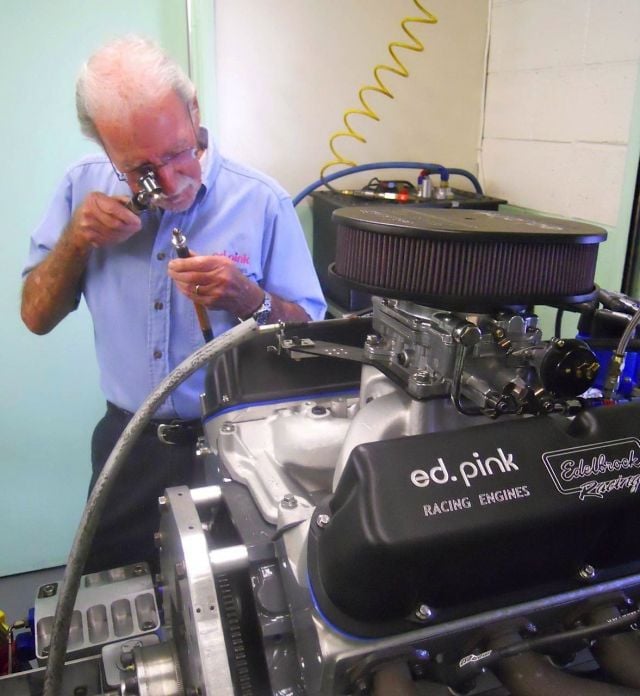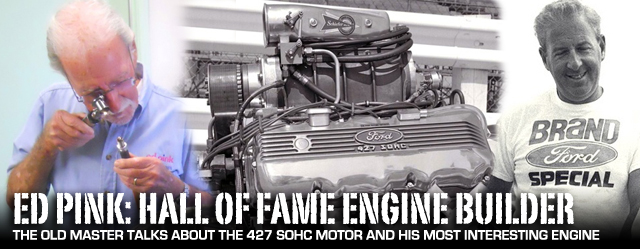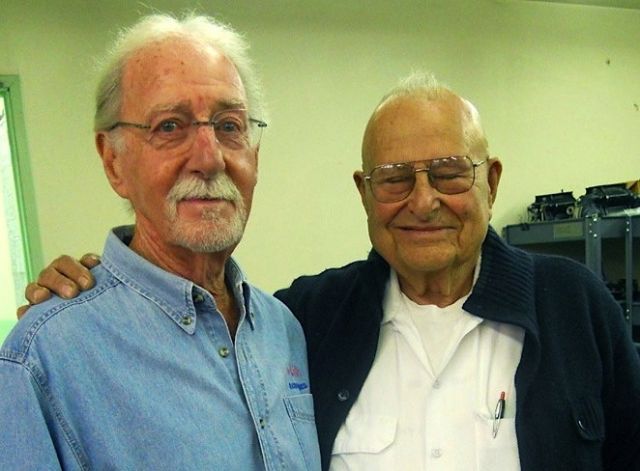Ed Pink, often recognized as the “Old Master” of engine builders, was recently inducted into the Motorsports Hall of Fame. His expertise stretches across many motorsport disciplines, but EngineLabs [2] was curious about his experiences with the rambunctious Ford 427 SOHC engine that ignited his early drag racing fame.
The Chrysler Hemi was a dominating force in NASCAR in the ‘60s when Ford developed the SOHC engine to compete on the high-banked ovals. But NASCAR banned the engine, so Ford directed the bulk of the engine inventory toward drag racing where the Hemi was also ruling the top fuel dragster class. On paper, the SOHC had some features favorable to drag racers, such as no pushrods and a strong combustion chamber. Part of the Ford plan launched a memorable 10-car A/FX project through Holman-Moody, and many other racers like Micky Thompson and Dyno Don Nicholson raced the SOHC engine in their respective classes.
 [3]
[3]Ed Pink, center, confers with owner Lou Baney and driver Tom McEwen. (Photos courtesy of Ford Motor Co.)
Once we got the engine developed, it could beat the Hemi.
— Ed Pink
The 427 SOHC engine came to Pink via good friend Lou Baney, who was running a Pink 392 Hemi in a fuel dragster driven by Tom McEwen. Baney owned a Ford dealership and wanted to showcase Ford power. Although Connie Kalitta and Pete Robinson received early engines, Ford inked a bigger deal with Baney because of the dealership connection and Pink was in the business of selling race engines.
“Connie and Pete just wanted to race. They didn’t want to build and sell engines,” says Pink who also counted Gas Rhonda among his SOHC customers.
SOHC motor’s weak link
From the start, Pink knew where to address the engine’s toughest shortcoming.
“The biggest problem was the cylinder block. It was maybe designed for a maximum of 750 horsepower,” explains Pink. “In those days we were doing 2,500 horsepower. The block was the weakest link. The task we had was to make it through four rounds of qualifying and four rounds of elimination without coming apart.
“Once we got the engine developed, it could beat the Hemi. But it was a difficult engine to work on,” adds Pink. “Being overhead cam, it wasn’t easy to repair between rounds. If you burned a piston at the track, you had to have another engine to put in the car or you went home.”
Pink needed about two months to build the first engine and get it to the track. Besides the block durability, another challenge was cam timing. The engine was based on a standard Ford 427 “hi riser” FE block, still with its standard cam core in the center of the block. The two overhead cams were driven by two chains: the first looked like a standard cam drive with a crank gear and a “stub cam” secured in the front two stock-location cam-bearings. Driven at half crank speed, the stub cam then drove a secondary chain around the two overhead cams. Pink had special chromoly chains made for the race engines, but the secondary chain was about six feet long had some flex, even with an idler gear and tensioner.
“The problem was that the driven cam was way ahead of the lagging cam,” says Pink. “One tooth on the gear was about 13 degrees. The way we ran the engine there was about a 7-degree split between the two cams.”
Pink could adjust the timing on each cam using special bushings that fit in the cam gear’s oblong mounting holes.
“It was really an on-going development from start to finish. One thing after another until it could go down the track without oiling the driver,” says Pink. “But we did get it to the point where it was formable force.”
Shining moment for SOHC program
Don Prudhomme replaced McEwen and led the team to its pinnacle at the 1967 NHRA Springnationals held at Bristol. Prudhomme posted the fastest qualifying time and became the first top fuel driver to break into ‘6s at a NHRA national meet. He also ran sub-7second times in three of four elimination runs (shut off early when opponent fouled in the other run). Prudhomme beat fellow Ford driver Pete Robinson in the final.
“That was definietly the shining moment for that engine,” boasts Pink.
The program slid to halt when Ford closed its pocketbook for any further engine development.
“It got to the point where it was running so hard, every weekend the block would crack. Ford gave us the block, heads and cam covers, but we had to make the rest.”
Pink resumed building Hemi engines and engaged in fierce rivalry with Keith Black in the top fuel dragster and funny car ranks.
“That was fun,” remembers Pink. “The tracks would have Black versus Pink races. Each of us would bring four customers. I was friends with him, but I wanted to beat him.”
Pink also branched out into Formula 5000, IMSA and IndyCar racing, including developing the Infiniti Indy V8 from the ground up when the old Indy Racing League (IRL) started.
“That was the most difficult project,” says Pink. “It was done with little money. I don’t think Japan had any idea of the scope of that project. But we finally got a win in Colorado with Eddie Cheever driving.”
When asked if there was one moment in his engine-development career that really stood out in terms of discovering a sizable chunk of horsepower, Pink points to a 4-cylinder midget engine based on the Ford-Yates cylinder head. Pink designed the fuel system and developed the cam formulas.
“I remember when we ran that engine on the dyno for the first time, it was about 60 horsepower better than any other midget engine we had done up to that time,” says Pink. “And we couldn’t wait to get it on the race track.”
Finally, when asked what what was the most “interesting” engine he ever worked on, the answer was somewhat surprising.
“The Mercedes 3.0-liter straight-6 that was in the 300SL. We’ve done about half dozen or so for customers,” says Pink, noting the engine’s unusual canted-angle block design. “It was built in the mid-‘50s and had direct fuel injection and dry sump–technologies we use today. It’s very interesting.”
 [6]
[6]Semi-retired, Pink still serves as a consultant to Ed Pink Racing Engines and recently helped build an engine for a SEMA charity.



